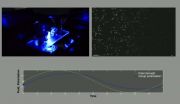(Press-News.org) BOSTON (June 5, 2015) -- A joint position statement outlining when, how and what type of Diabetes Self-Management Education and Support (DSME/S) should be delivered to patients is being released today at the American Diabetes Association's 75th Scientific Sessions. The statement is also being published online concurrently in Diabetes Care, The Diabetes Educator and the Journal of the Academy of Nutrition and Dietetics.
The statement -- written by representatives of the American Diabetes Association, American Association of Diabetes Educators (AADE) and the Academy of Nutrition and Dietetics (AND) -- provides an algorithm with guidance to health care providers regarding when to refer patients with diabetes to Certified Diabetes Educators (CDEs) and other trained staff for education and support. DSME/S, recognizing that the person with diabetes is their own primary care provider, refers to the information and skills people with diabetes need for proper self-care and the support they need to implement those skills and behaviors.
Specifically, the statement highlights four critical times for assessing the need for DSME/S referral: at diagnosis; on an annual basis; when new complicating factors influence self-management and, lastly, when transitions in care occur. The statement also provides guidance on the type of information and support patients might need at these critical junctures. For example, the guidelines suggest that immediately following diagnosis, education should focus on safety concerns, coping with the diagnosis and the process of incorporating self-management into daily life. Annual assessments would review and reassess treatment goals and self-management needs, problem-solving skills, make any needed adjustments to therapy and address any concerns or questions the patient may have. Complicating factors could include new health conditions or physical limitations. Life transitions and changes in health status would require more personalized information and support to help patients address individual needs. The algorithm also outlines the content to be taught, roles and action steps recommended for both the referring provider and for the diabetes educator.
"We have algorithms for when and how to advance medication for patients with diabetes, but there has never been an algorithm for starting and advancing self-management education," said Margaret Powers, PhD, RD, CDE, Research Scientist at the International Diabetes Center at Park Nicollet and President-Elect, Health Care & Education, for the American Diabetes Association. "If you ask clinicians when should diabetes education occur, you'll get a variety of answers. We needed a clear set of guiding principles for when to provide and how to assess a patient's needs for DSME/S. This document provides that necessary guidance."
Research has shown that DSME/S improves diabetes outcomes, including helping to reduce A1C levels; reducing the onset and/or advancement of diabetes complications; improving lifestyle behaviors, such as eating a more healthful diet and exercising more frequently; and decreasing diabetes-related distress and depression. Studies have also shown it to be cost effective by reducing hospital admissions and readmissions.
"We know that diabetes education works," said Joan Bardsley, MBA, RN, CDE, FAADE, Assistant Vice President of Medstar Health Research Institute and Immediate Past President of the American Association of Diabetes Educators. "But one of the major gaps we have seen is that there aren't a lot of providers who will routinely refer patients to diabetes educators. Either they don't know how to make these referrals, can't find an educator or don't understand how valuable diabetes education can be for people living with diabetes."
"Yet those referrals are critical," said Linda Siminerio, RN, PhD, CDE, Professor of Medicine at the University of Pittsburgh and Chair of the National Diabetes Education Program. "Referrals influence patient behavior a great deal. When providers refer patients to diabetes education, we see an 83 percent participation rate, but without those referrals participation is abysmally low. If patients believe their physicians think diabetes education is important, they take it a lot more seriously. Patients trust their providers."
Bardsley emphasized that education and support are needed throughout a person's lifetime, not just at diagnosis. "Diabetes is a chronic disease, and what a patient needs changes over time," she said. "That's why it's important that people are referred not just one time, but many times throughout their lives, to ensure they are getting all of the information and support that they need to properly manage their diabetes as they go through the different stages of life."
"I think that diabetes education has always been acknowledged as a key part of diabetes care," said Melinda Maryniuk, MEd, RD, CDE, Director of Care Programs at Joslin Diabetes Center, who represented the Academy of Nutrition and Dietetics on the working group that crafted the position statement. "But some physicians don't realize what's really involved in diabetes education. This document outlines the key elements of diabetes education and support and when we think they are most needed, so primary care physicians and endocrinologists can recognize that it's more than telling someone at diagnosis, 'Here's how you take your insulin.'"
INFORMATION:
The American Diabetes Association is leading the fight to Stop Diabetes® and its deadly consequences and fighting for those affected by diabetes. The Association funds research to prevent, cure and manage diabetes;
delivers services to hundreds of communities; provides objective and credible information; and gives voice to those denied their rights because of diabetes. For the past 75 years, our mission has been to prevent and cure diabetes and to improve the lives of all people affected by diabetes. For more information please call the American Diabetes Association at 1-800-DIABETES (800-342-2383) or visit diabetes.org. Information from both these sources is available in English and Spanish.
Scientists have defined the smallest, most accurate thermometer allowed by the laws of physics -- one that could detect the smallest fluctuations in microscopic regions, such as the variations within a biological cell.
The research, involving mathematicians at The University of Nottingham and published in the latest edition of the journal Physical Review Letters, focuses on the sensitivity of thermometers made up of just a handful of atoms and small enough to exhibit distinctive 'quantum' features.
Devising sensitive and practical nano-scale thermometers would represent ...
Honest behavior is much like sticking to a diet. When facing an ethical dilemma, being aware of the temptation before it happens and thinking about the long-term consequences of misbehaving could help more people do the right thing, according to a new study.
The study, "Anticipating and Resisting the Temptation to Behave Unethically," by University of Chicago Booth School of Business Behavioral Science and Marketing Professor Ayelet Fishbach and Rutgers Business School Assistant Professor Oliver J. Sheldon, was recently published in the Personality and Social Psychology ...
This news release is available in German. Most magnetic materials have a structure that is somewhat more complicated than a commercially available domestic magnet: they not only have a north and south pole, but a variety of sectors, often only a few nanometres in size, in each of which the magnetic axis points in a different direction. These sectors are referred to as domains. Over the past few years, Manfred Fiebig, Professor for Multifunctional Ferroics at ETH Zurich, has been studying the walls between adjoining domains in certain materials. "The inner workings of ...
When a woman becomes pregnant or is planning a pregnancy, one of her first decisions is where she will deliver her baby. With options ranging from birthing centers to small community hospitals to regional health networks to academic medical centers, the decision can be confusing.
The question, especially for a woman with a low-risk pregnancy, is "What is the likelihood that something could go wrong?"
Research on this topic has been published in the American Journal of Obstetrics & Gynecology. The research was conducted by Valery A. Danilack, MPH, PhD, postdoctoral ...
Researchers from the UAB and the University of Nottingham, in an article published today in Physical Review Letters, have fixed the limits of thermometry, i.e., they have established the smallest possible fluctuation in temperature which can be measured. The researchers have studied the sensitivity of thermometers created with a handful of atoms, small enough to be capable of showing typical quantum-style behaviours.
The researchers characterised these types of probes in detail, devices which could provide an estimation of the temperature with a never before seen precision. ...
June 5, 2015 - Young infants who can "resettle" themselves after waking up are more likely to sleep for prolonged periods at night, according to a video study in the June Journal of Developmental & Behavioral Pediatrics, the official journal of the Society for Developmental and Behavioral Pediatrics. The journal is published by Wolters Kluwer.
"Infants are capable of resettling themselves back to sleep by three months of age," according to the study by Ian St James-Roberts and colleagues of the University of London. They add, "Both autonomous resettling and prolonged ...
Nanofibers -- polymer filaments only a couple of hundred nanometers in diameter -- have a huge range of potential applications, from solar cells to water filtration to fuel cells. But so far, their high cost of manufacture has relegated them to just a few niche industries.
In the latest issue of the journal Nanotechnology, MIT researchers describe a new technique for producing nanofibers that increases the rate of production fourfold while reducing energy consumption by more than 90 percent, holding out the prospect of cheap, efficient nanofiber production.
"We have ...
One mystery of birds' flight is solved! The elegance of birds' flight, their seemingly effortless aerial turns and the softness of their landing, have been envied by many people. From countless observations, it has been known that the birds use a small group of feathers, called "the alula", a thumb-like structure that is present at the bend of the wing, in slow and steep flight such as landing. Why do they use it? How the tiny feathers can help them land softly?
A recent article published in Scientific Reports says that the secret is a small vortex of air that is formed ...
Researchers from Uppsala University, together with colleagues at University College Dublin, have studied the dynamics of active swarms using computer simulations and experiments on unicellular algae. The team not only found full analogy of the active motion in a field to magnetic hysteresis but also managed to quantify the controllability of the swarm and identify the signatures of collective behavior of the active agents.
Active motion of living organisms and artificial self-propelling particles has been an
area of intense research at the interface of biology, chemistry ...
Dublin, June 4th 2015 - Biochemists from Trinity College Dublin have devised a new technique that will make the difficult but critical job of blueprinting certain proteins considerably faster, cheaper and easier.
The breakthrough will make a big splash in the field of drug discovery and development, where precise protein structure blueprints can help researchers understand how individual proteins work. Critically, these blueprints can show weaknesses that allow drug developers to draw up specific battle plans in the fight against diseases and infections.
Professor ...


